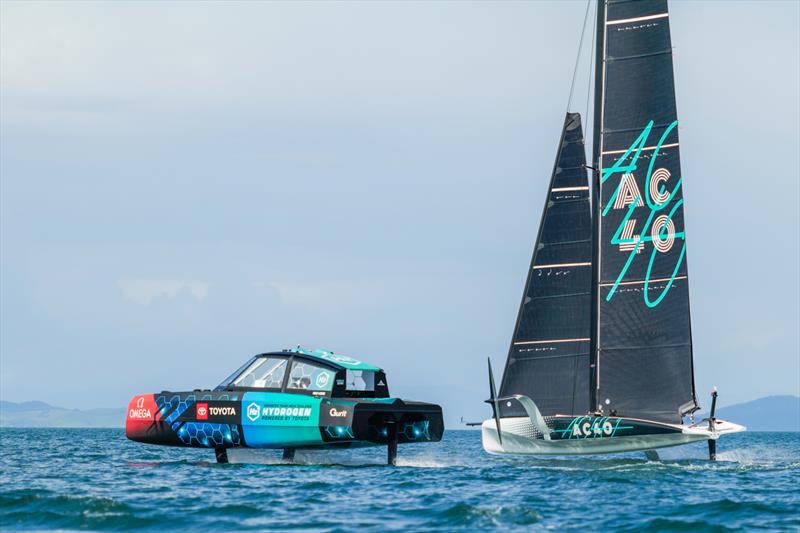
Cup Spy: Kiwis keep rudder in the water and mast in the sky - AC40 Day 1
by Richard Gladwell/Sail-World.com/nz 22 Sep 2022 00:33 PDT
22 September 2022

ETNZ AC 40 - America's Cup Joint Recon Emirates Team New Zealand AC40 Day 2 - September 21, 2022 © Adam Mustill / America's Cup
Emirates Team New Zealand took the first AC40 test boat on its maiden sail yesterday. The following is based on content available in the AC37 Joint Reconnaissance Program, collected by the two NZ based Recon Team members.
Nathan Outteridge was interviewed after the first sail by the AC37 Joint Reconnaissance program to get his impressions of the day, and of the AC40.
Outteridge says that he has not sailed a foiling monohull before, however he does have plenty of foiling experience. That includes Foiling Moths to AC50's in the 2017 America's Cup. He has sailed for over two seasons on the SailGP circuit making the Final in both seasons. He is a former World Champion and Olympic Gold and Silver medalist in the Olympic 49er class.
Conditions on Course E of the 2021 America's Cup were a northerly wind of 8-12kts.
Key point's and impressions from the first sail:
"We were on autopilot, having done all the towing tests yesterday, which went well. We towed at 25kts most of the way, and the autopilot (flight control system) did its job.
"We can manually control our height and trim. The height is done by pushing Plus and Minus buttons which adjust by 100mm increments. The trim is similar and just changes the attitude of the boat.
"She's wet on takeoff, but when you're in the air it's quite enjoyable.
"It took us a little while to work out how to get the foil engaged to get a bit of speed. It's a combination of the main sheet load and mast rotation and cunningham.
"Of the commissioning team, none of the guys - myself, Ray (Davies), Nick (Burridge) or Sam (Meech) sailed on the AC75 last time around. So we had lots of conversations and after a while we worked out the correct settings, to get it to get over 10 knots which is when the foil engages and at that point, you're into a massive trim on because the righting moment comes so quickly and you are doing 25kts before you know it.
"I think the ride height on the auto pilot (flight control) is pretty good, upwind. And then as soon as you start to increase speed or you start to reach, or you start to go downwind, I think the speed at which the boat is going through the waves is, quite different.
"I think they went through similar things in the foiling chase boat - when you have a high frequency and you're going through the waves, the boat responds nicely. But when you're going through the wave slower or a car ferry goes past - you get a bit of porpoising - that's expected - and the guys working on the autopilot were not too surprised by that.
"If that was our biggest concern today, that's cool.
"We never expected the boat to work perfectly out of the box.
"We'll have a couple of weeks to make sure that we know everything on the boat's working well. It was perfect conditions for our sailing today.
"You wouldn't want to have the porpoising around that much if you're going much quicker. But you just do your best as a sailor and keep the rudder in the water and keep the mast in the sky!
Images of the Day: